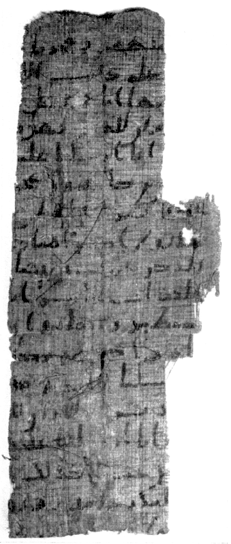The following
Qur’anic Papyrus

Recto

Verso
The textual reconstruction may be viewed here.
Qur’an [S 54:11 – 38, 45 – 55 ; 55:1 – 32].
Brown, fine papyrus. 14.8 x 5.9 cm.
On the recto twenty lines, containing S‑4:11 – 38, are written in black ink parallel to the horizontal fibers, the verso bears eighteen lines, running at right-angles to the vertical fibers, containing verses 45?55 of s?4, and verses 1 – 32 of S‑5.
In the line 4, at the end of verse 50, a verse-division mark is visible. S?4 is divided from 55 by two parallel horizontal lines running over the full width of the page, and filled in with an ondulating [undulating, Asif] line with pearls in the compartments.
Place of discovery unknown.
The script has become obliterated in some places and the papyrus is torn upon all sides. The fragments shown here comes from the middle of the page, which as the line originally contained about three times as much as at present, would have been about 17.7 cm wide.
The Qur’an was certainly destined for private use only, and belongs to the small, oblong sizes, particularly used for private owners already in very early times.
Before entering into the question of dating[1] it will be recommendable to give a paleographical analysis of the script of P. Michaelides 32. The Alif (line 8), the most significant letter of the Arabic alphabet, as J. v. Karabacek has said[2], shows a definite bend to the right side, as it is already the case in PER Inv. Ar. Pap. 94 (ca. 30 A. H., 650 A. D.)[3]. It differs therefore from the straight, vertical Alif in PERF no 558[4], in the bi-lingual protocol BM 1473[5], in Arabic Paleography Pl. 43 and in the Quran Paris, Arabe 328[6] as well as from the Alif, curved to the right at the basis, shown by the Quran Med 1a in the Saray in Istanbul[7].
The D?corresponds to the form offered by PERF no 558, P. Berol. 15002, P. Mich. 6714, P. Berol. 9177 (124 A. H., 742 A.D.) and the parchment-Qur’an Paris Arabe 328 (1).
The R?Zay) is similar to the same letter in PERF no 558, P. Berol. 15002, PERF no 573 (57 A. H., 677 A. D.)
In S the tail of the final-letter (recto line 6) goes down in an almost straight line, as in the N?curring in PERF n ? 558, 573, PER Inv. Ar. Pap. 94. It therefore differs from the final‑S?with a curved tail occurring e. g. in PERF n ? 558.
The T?as a rectangular body and a vertical stroke bending to the right side, as e. g. in Paris Arabe 328 (4)[8]. The latter characteristic feature already occurs in PERF n ? 558 and P. Loth II, further in the legend of the copper coins from the second decade of the first century of the Hijra[9] and in the Qurra-papyri[10], where it interchanges with the straight form. This characteristic feature is preserved in the third century of the Hijra (9th century A. D.) in the papyrus script[11], and in early Arabic manuscripts forming the transition to Maghrab?riting[12], in which it is preserved until recent times.
Possibly this form of the T?as also significant for the Makk?cript while the old scripts of al‑K?al-Basra and Damascus preferred the vertical stroke.
The Nos about the same form as in PER Inv. Ar. Pap. 94.
An additional characteristic feature is the reverted Y?e.g. in Al?ecto line 2 and in F?erso line 9, 16).
All these characteristics show, together with the general impression of the writing, that the script of P. Michaelides no 32 cannot be dated later than the first century of the Hijra (end of the seventh or beginning of the eighth century A. D.).
Notes
[1] The dating second/third century of the Hijra, given in from the World of Arabic Papyri, p. 229, note 268, refers to the papyrus-Qur??leaf P. Michaelides no 190 (not to no 32).
[2] WZKM v (1891), p. 323.
[3] cf., my Aper?de papyrologie Arabe, Studes de papyrologie 1 (1930), Pl. ix.
[4] cf., the Table of Writing in CPR III, 1⁄2, p. xxii.
[5] cf., ZA xxii (1908), Pl. 1 line 6.
[6] cf., G. Bergstresser, Geschichte des Qorans, III, Pl. vii.
[7] ibid, Pl. viii.
[8] E. Tisserant, Specimina codicum Orientalium (Bonn, 1914), Pl. 41b.
[9] cf., J. v. Karabacek, Beitrege zur Geschichte der Mazjaditen (Leipzig, 1874), p. 35 ; WZKM, v, (1891), p. 324.
[10] E. G. APEL III n ? 147?3, 5, Pl. II (91 A. H., 710 A. D.)
[11] APEL III n ? 167?94, 94 Pl. xi (140 A. H., 757 A. D.), 180?5, 7 Pl. xv (113 A. H., 731⁄32 A. D.), 210?26 Pl. xxi (ca. 116 A. H., 734 A. D.), APEL II n ? 79?8, 9 Pl. iv (third cent. A. H., ninth cent. A. D.), 82?4 Pl. vi (253 A. H., 867 A. D.), 91?3 Pl. vii (second-third cent. A. H., ninth cent. A. D.), 120?4 Pl. xix (third cent., ninth cent. A. D.), APEL IV n ? 233 r/5, 7 Pl. vii (third cent. A. H., ninth cent. A. D.); J. D. Weill, Le Dj?‘ d?Ibn Wahb I (Cairo, 1939), Pl. 5, 7 (second half of the third cent. A. H., ninth cent. A. D.)
[12] e. g. in the translation of the New Testament, which H. L. Fleischer, Beschreibung der von Prof. Dr. Tischendorf zur?rachten christlich-arabischen Handschriften, ZDMG viii (1854), p. 585 dates in the eighth, at the latest ninth century A. D.

